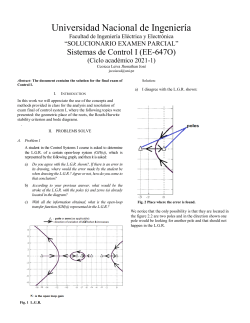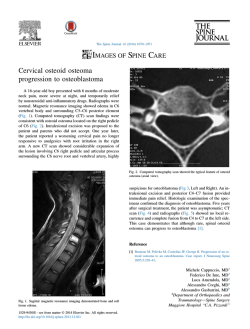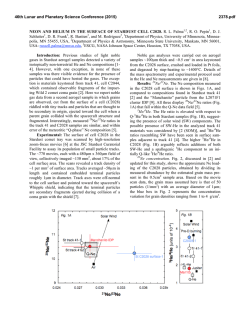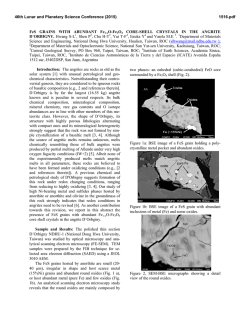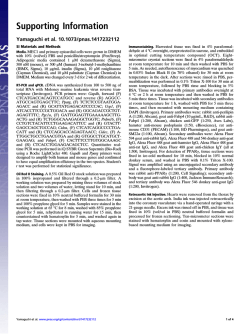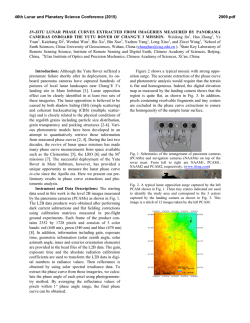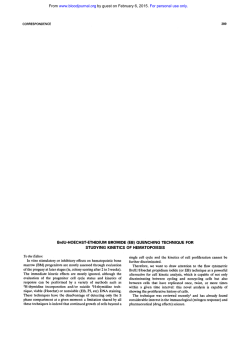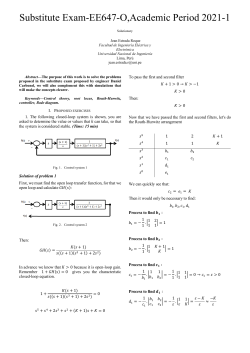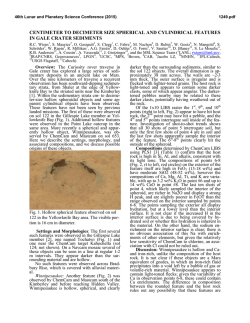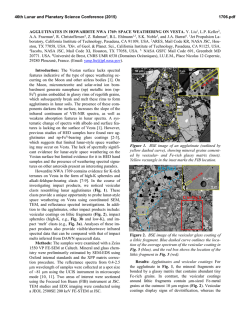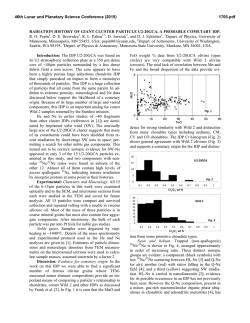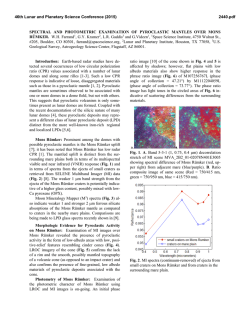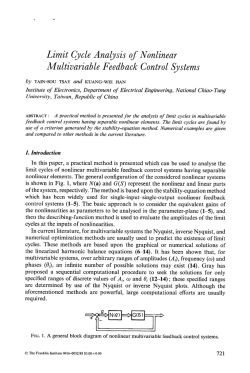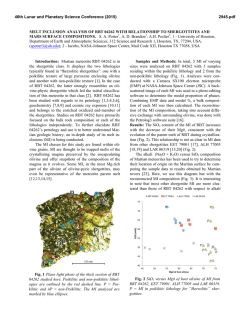
A New Potassic Hollandite (KAlSi
46th Lunar and Planetary Science Conference (2015) 1401.pdf LIEBERM MANNITE: A NEW POTAS SSIC HOLLA ANDITE (KAllSi3O8) FROM M THE ZAGA AMI BASALTIIC 2 SHERGO OTTITE. Chi Ma M 1,3, Oliver Tschauner T , Joh hn R. Beckett1, George R. Roossman1. 1California Institutee of Technolog gy, Pasadena, CA C 91125, USA A, 2University of Nevada, Laas Vegas, NV 889154, USA, [email protected]. Introduction: Basalttic shergottites provide key in nsights into igneous proceesses on Mars [e.g., [ 1] but theey are also hig ghly shocked, thereby provid ding informatio on about shocck conditions during d the exccavation of sam mples from Mars M and of sh hock processes in general [e.g g., 2-3]. In this work, we deescribe a new shock-produceed mineral, liebermannite (L Lieb), KAlSi3O8 in a holland dite-type strructure, and co oexisting phases from Zagam mi using SEM M, EPMA, EB BSD, and syncchrotron diffraaction. This phase was preeviously reportted in the basaaltic shergotttites Zagami and a NWA 480 0 based on chaaracterization n using ATEM M, EPMA, and d Raman but not n named [2--3]. The nam me liebermanniite (IMA 2013128) honorrs the mineral physicist Rob bert Lieberman nn for his man ny contribution ns to the experimental study of o phases at elevated e pressu ures and temperratures. Samplee and Analysses: The doublly polished th hin section of Zagami used in this study was w kindly pro ovided by E.M. E Stolper. The section is i dominated by b augite, pig geonite and maskelynite with minor mesosttasis and acccessory silicaa, merrillite, apatite, a fayalitte, ilmenite, tiitanomagnetitee, baddeleyite, and Fe-sulfid de; the basic petrography p is consistent with h an NZ litholo ogy (“normaal Zagami”) [1,4]. Melt pock kets are rare an nd we observeed only one sh hock vein. Thu us, high pressu ure phase asseemblages occurr sporadically; observed shocck phases incclude stishovitee (St), tuite, liingunite, liebeermannite an nd CAS. Properrties of lieberm mannite: Liebermannite is th he hollandite--structured poly ymorph of KA AlSi3O8 in whicch edge-sharin ng octahedra, containing Al A and Si, forrm chains parrallel to the c-axis that are corner c linked to form cavities containing the K. In Zag gami, lieberman na nite occurss in <~15 m aggregates. We were unable to o obtain EBS SD patterns on o Zagami lieebermannite bu ut established the t crystal stru ucture through synchrotro on diffraction; data were ob btained on the t regions sho own in Fig. 1 using a primarry beam energ gy of 25 keV (0.59494 ( Å) monochromatize m ed by a doublle crystal Si 111 monochrom mator. Based on o synchrotro on diffraction data, d lieberman nnite is a tetrag gonal phasee crystallizing in the I4/m sp pace group with cell param meters for the type t example (Fig. ( 1) of a = 9.140±0.03 36 (1) and c = 2.736±0.021 Å, which leaad to a cell vo olume of 228.5 56±0.25 Å 3. Th he a-cell dimen nsion is notticeably shorteer than values reported in th he Fig. 1. BSE image showing liebeermannite with linguunite, a silica pphase (probablyy stishovite), illmenite annd baddeleyitee; the assemblaage is surroundded by auugite with nearrby maskelynitte and titanomaagnetitte. Fig. 2. In this occuurrence, lieberm mannite (basedd on mposition and trransparency) w with included comp stishhovite is boundded by merrillitte, augite, and maskkelynite. literatuure for synnthetic and meteoritic Na/Khollanndites, which aare 9.26 Å [22,5-8]. This m may reflect syystematic erroors for powder diffraction in literature m measurements bbut is more likeely to imply diffferent vacanccy populations on the M-site or, possibly, different deegrees of site disorder or reesidual strain in the Zagam mi material. It pprobably does not suggest strrongly negativve volumes off mixing along the NaAlSi3O8 (Ab) - KAl Si3O8 (Or) joiin, as availablle experimentaal data [9] aree consistent witth ideal volum mes of mixing. 46th Lunar and Planetary Science Conference (2015) Fig. 3. Compositions of liebermannite and lingunite (this study), Na-K-Ca hollandites [2-3], and mesostasis and maskelynite [1] from Zagami in terms of Or-AbCaAl2Si2O8(An). Mesostasis compositions are projected from SiO2. The composition of type liebermannite by EPMA is 65.36 wt% SiO2, 19.00 Al2O3, 13.02 K2O, 1.62 Na2O, and 0.37 CaO (summing to 99.36%), which leads to a formula of (K0.76Na0.14Ca0.02)Al1.03Si3.00O8 and a density of 3.975 g/cm3. Fig. 3 shows compositions of liebermannite and lingunite (the Na analog of liebermannite) from Zagami together with those of maskelynite and mesostasis [1]. Liebermannite compositions are generally consistent with those of K-rich mesostasis compositions (projected from silica) and it is, therefore, likely that K-rich mesostases were precursors to liebermannite. In contrast, lingunite compositions are substantially more calcic than K-poor mesostases; they plot with maskelynite in Fig. 3, making plagioclase and not K-poor mesostasis the likely precursor. According to [1], K-rich mesostases are more strongly reddish in plane light than K-poor mesostases (reconnaissance tests confirm their observation for our section). Only one (K-rich) liebermannite occurrence (Fig. 1) was established using synchrotron diffraction but it is optically transparent. It may therefore be possible to identify liebermannite-containing regions in Zagami through the simple artifice of connecting Kmapping by EPMA to determine locations of Kenriched regions and then using color to determine which of these contain liebermannites (e.g., Fig. 2). Discussion and Conclusions: NaAlSi3O8 may not have a hollandite stability field at all (e.g., [10]); meteoritic lingunites may be stabilized by Ca) but liebermannite exists stably under a broad range of P-T and bulk composition [e.g., 5-6,9], as shown in Fig. 4. At 1400°C, the low Ca-liebermannite plus stishovite (no 1401.pdf Fig. 4. Phase diagram for the NaAlSi3O8- KAlSi3O8 join at 1400°C (red & labeled fields) and 2000°C (blue) after [9] with compositions of Zagami liebermannites with <3 mole % An component from this study shaded in gray. Holl-II: I2/m hollandite; Jd: jadeite; Cf: Ca-ferrite structured (Na,K)AlSiO4. pyroxene) of Figs. 1-2 would be stable at ~19-21 GPa, bounded at high P by the breakdown of liebermannite to an orthorhombic (K,Na)AlSi3O8 structure and at low P by the formation of pyroxene and stishovite. At higher T, the stability field expands both to low (~17 GPa at 2000°C) and, especially, high P. Most likely, liebermannite crystallized during cooling of high-K mesostasis composition melts that were originally produced during low-P, very late-stage crystallization of Zagami basalt, and then reheated to high P-T during a shock event. The heat source for liebermannite occurrences shown in Figs. 1-2 is uncertain as the melt vein and pockets are >800 m away. It is possible that a melt pocket or vein out of the plane of the section provided the heat source. Alternatively, cracks or voids in or near rare mesostases collapsed during shock, leading to hot spots that heated the local mesostasis sufficiently so that stishovite and/or silica glass plus liebermannite could form. References: [1] Stolper E. and McSween H.Y. (1979) GCA 43, 1475-1498. [2] Langenhorst F. and Poirier J.-P. (2000) EPSL 176, 259-265. [3] Beck P. et al. (2007) GRL 34, L01203. [4] McCoy T.J. et al. (1992) GCA 56, 3571-3582. [5] Boffa Ballaran T. et al. (2009) Phys. Rev B., 80, 214104. [6] Yagi A. et al. (1994) Phys. Chem. Min., 21, 12-17. [7] Ferrior T. et al. (2006) Am. Min. 91, 327-332. [8] Gillet P. et al. (2000) Science 287, 1633-1636. [9] Liu X. (2006) EPSL, 246, 317-325. [10] Deng L. et al. (2010) EPSL 298, 427-433.
© Copyright 2026
